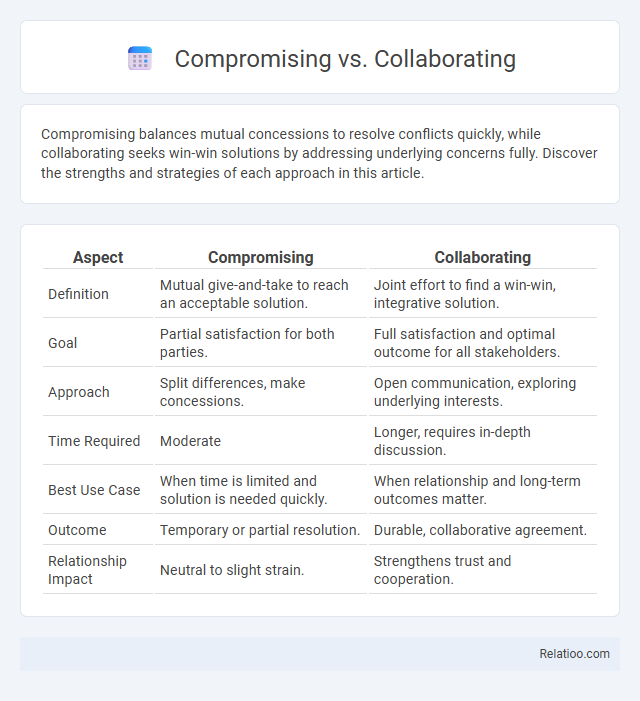Compromising balances mutual concessions to resolve conflicts quickly, while collaborating seeks win-win solutions by addressing underlying concerns fully. Discover the strengths and strategies of each approach in this article.
Table of Comparison
| Aspect | Compromising | Collaborating |
|---|---|---|
| Definition | Mutual give-and-take to reach an acceptable solution. | Joint effort to find a win-win, integrative solution. |
| Goal | Partial satisfaction for both parties. | Full satisfaction and optimal outcome for all stakeholders. |
| Approach | Split differences, make concessions. | Open communication, exploring underlying interests. |
| Time Required | Moderate | Longer, requires in-depth discussion. |
| Best Use Case | When time is limited and solution is needed quickly. | When relationship and long-term outcomes matter. |
| Outcome | Temporary or partial resolution. | Durable, collaborative agreement. |
| Relationship Impact | Neutral to slight strain. | Strengthens trust and cooperation. |
Understanding Compromising and Collaborating
Compromising involves each party giving up part of their demands to reach a mutually acceptable solution, balancing assertiveness and cooperation. Collaborating entails working together to find innovative solutions that satisfy the interests of all parties, promoting win-win outcomes through deeper understanding and trust. Your ability to discern when to compromise or collaborate enhances conflict resolution and strengthens relationships.
Key Differences Between Compromising and Collaborating
Compromising involves each party giving up something to reach a mutually acceptable solution, often resulting in a middle-ground outcome with partial satisfaction. Collaborating focuses on working together to find a win-win solution that fully satisfies both parties' interests by addressing underlying needs and concerns. Your choice between compromising and collaborating depends on whether you prioritize quick resolution or creating a lasting, optimal pattern for problem-solving.
When to Choose Compromising in Conflict Resolution
You should choose compromising in conflict resolution when both parties need a quick, mutually acceptable solution without fully satisfying either side's goals. This approach works best in situations where time constraints exist, and the issue holds moderate importance, allowing you to preserve relationships while addressing immediate concerns. Compromising minimizes potential escalation by balancing concessions, making it an efficient pattern when cooperation is essential but full collaboration isn't feasible.
When to Choose Collaborating in Conflict Resolution
Collaborating in conflict resolution is ideal when both parties' interests are important and a win-win solution is needed, ensuring long-term relationship building and mutual satisfaction. You should choose collaborating when the issue is complex, requires creative problem-solving, and when maintaining trust and open communication is essential. This approach leverages diverse perspectives to generate innovative solutions, avoiding the pitfalls of compromise or avoidance patterns.
Advantages of Compromising
Compromising offers quick conflict resolution by finding middle ground, allowing both parties to gain partial satisfaction without prolonged disputes. This approach conserves time and resources, making it ideal for situations where maintaining relationships and achieving immediate agreement are priorities. Your ability to compromise fosters cooperation and keeps communication open for future collaboration.
Advantages of Collaborating
Collaborating allows you to leverage diverse perspectives and expertise, resulting in innovative solutions that address everyone's core concerns. The collaborative approach fosters stronger relationships and higher trust, creating a foundation for long-term cooperation and mutual benefit. Unlike compromising, collaborating doesn't require sacrificing key interests, ensuring that all parties achieve optimal outcomes.
Disadvantages and Risks of Compromising
Compromising often results in partial satisfaction for all parties, leading to unresolved issues and potential resentment that can harm long-term relationships. The risk lies in settling for solutions that lack true commitment, which may cause recurring conflicts and reduced trust. Your ability to build strong, lasting agreements diminishes when compromises prioritize quick fixes over collaborative problem-solving.
Disadvantages and Risks of Collaborating
Collaborating often requires significant time and effort, which can delay decision-making and hinder quick resolutions. You may face challenges such as imbalance in participation, where dominant voices overshadow others, leading to potential resentment or disengagement. The risk of over-reliance on group consensus might result in compromised solutions that fail to fully address critical issues or individual needs.
Real-World Examples of Compromising vs Collaborating
Compromising involves both parties making concessions to reach a middle ground, such as two companies agreeing to split market territories to avoid direct competition. Collaborating focuses on creating value by working together, exemplified by technology firms combining resources to innovate and co-develop new products. Your choice between compromising and collaborating can impact long-term relationships and the potential for breakthrough solutions.
Strategies for Effective Conflict Management
Compromising, collaborating, and pattern recognition are key strategies for effective conflict management in organizational settings. Compromising involves finding a middle ground where each party concedes some demands, fostering quick resolution but potentially sacrificing optimal outcomes. Collaborating emphasizes open communication and joint problem-solving to address underlying interests, leading to innovative solutions and stronger relationships, while recognizing conflict patterns helps anticipate and prevent recurring disputes by implementing proactive interventions.

Infographic: Compromising vs Collaborating
 relatioo.com
relatioo.com